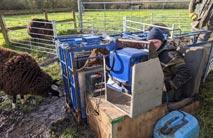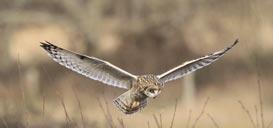
4 minute read
Field And Stream
Field & Stream Fascinating world of a sheep scanner
THE FIELD
with Tria Stebbing
On a very muddy Sunday two weeks ago, Alex the sheep scanner came out to the field. We had managed to get the girls up to the road gate and rather surprisingly they did exactly as we wanted them to do. Alex had been out to the flock before and the ewes that he was scanning were the babies that he picked up on his scanner two years ago, otherwise known as the Sheep Circle of Life. Sheep scanning is fascinating: Alex arrives with his kit, sets up and we coax the ewes into the scanning area. Everyone holds their breath whilst the first goes in, the images come up on the screen and we can make out faint heartbeats. It has been a long journey, from flushing them through last September to putting the ram in last October, then waiting. What excellent results…. Three sets of twins, one set of triplets and two large singles. That is certainly going to be a busy couple of weeks. Ironically, my mis-marked Disney princess who failed miserably to meet the breed standard is carrying triplets, it will be interesting to see who had the strongest gene pool there. As the ram was wearing his raddle, we have a good idea of due dates, but I am sure there will be the usual surprise. So now the fun begins. They are on good grass, which we had managed to save by keeping them on summer grazing for longer, so not having to supplement yet. The hay which we cut and baled ourselves on a hot day last July, they go mad for, quite rightly so as it is lovely meadow hay. They have a lick bucket to provide the extra minerals and occasional treats of a few brussels sprouts. We will now spend time planning the nursery, who goes where and who needs what.
Heat lamps, hot water bottles, iodine, gloves, disinfectant, and bales of straw are next to organise. After the excitement of the scanning, him indoors spent the weekend laying the road hedge. It was a bit of a beast as it had got very thick and unkempt, lots of blackthorn thorns in the fingers. Having finished we were able to update the villagers on the exciting news as most were taking their daily walk. I should add that we really appreciate the interest that the villagers show in what we are trying to achieve with the field, and we are grateful to them for keeping a watchful eye on the ewes too. Having sorted the hedge, the view of the lambs should be much better for people walking past in the spring. I really hope that the arrival of the 11 lambs will herald the start of safer and happier times for us all.
AMAZING SIGHTS; Alex at work and, inset, a scan on screen
Nature treats us to a winter spectacle
By David Bailey
Heralding in the New Year with the glowing thought that warmer and longer days are just a few weeks away it is the time to explore our natural world in its naked winter glory. One such January day I spent filming kestrels for a BBC series just along the ridge from Compton Abbas Airfield. Capturing footage of a black silhouette outlining this skilled hunter, hovering with car headlights passing behind was worth every freezing minute. That’s one of the many natural beauties that can be spied from our high downland viewpoints. Looking down on the backs of buzzards hovering on updrafts wafting through the coombes and red kites swooping down behind tractors working the land uplifts the heart. On the chalk downlands rare hen harriers hunt the hedgerows of fields, the male bird looking spectacular with its black, white and grey plumage. A rare but more regular visitor to the area are Great Bustards from Salisbury plain. Enduring a severe cold winter, hungry species may be seen desperately searching for food such as foxes, with their red coats looking even more resplendent in snow. It is also their mating season when their screaming call is heard at night. Roe deer add winter magic, often seen around the Vale. At lower levels short eared-owls are known for hunting during the day and are often seen quartering areas of marsh. Another owl, the tawny famous for its comforting ‘twit-twoo’ call is often heard at night in town and country. Love or hate them it is the breeding season of the red squirrel’s nemeses – the dreaded grey. Readily seen in town or country the grey drove out our native reds, who cling on in small areas of England due to the marvellous work of the Red Squirrel Survival Trust. Large numbers of chattering migrant fieldfares gather in fields after returning from Scandinavia. Starlings, which can be seen here all year round, are boosted by numbers from Europe gathering in huge numbers, offering the most intriguing sight of murmurations in the dying light of day. Forming swirling and everchanging black shapes in the sky before falling earthward in vast funnel shapes to roost. Why? Several theories abound the one I see fit for purpose is safety in numbers from predators. However for once it’s nice for nature to keep its secret.

A short-eared owl









